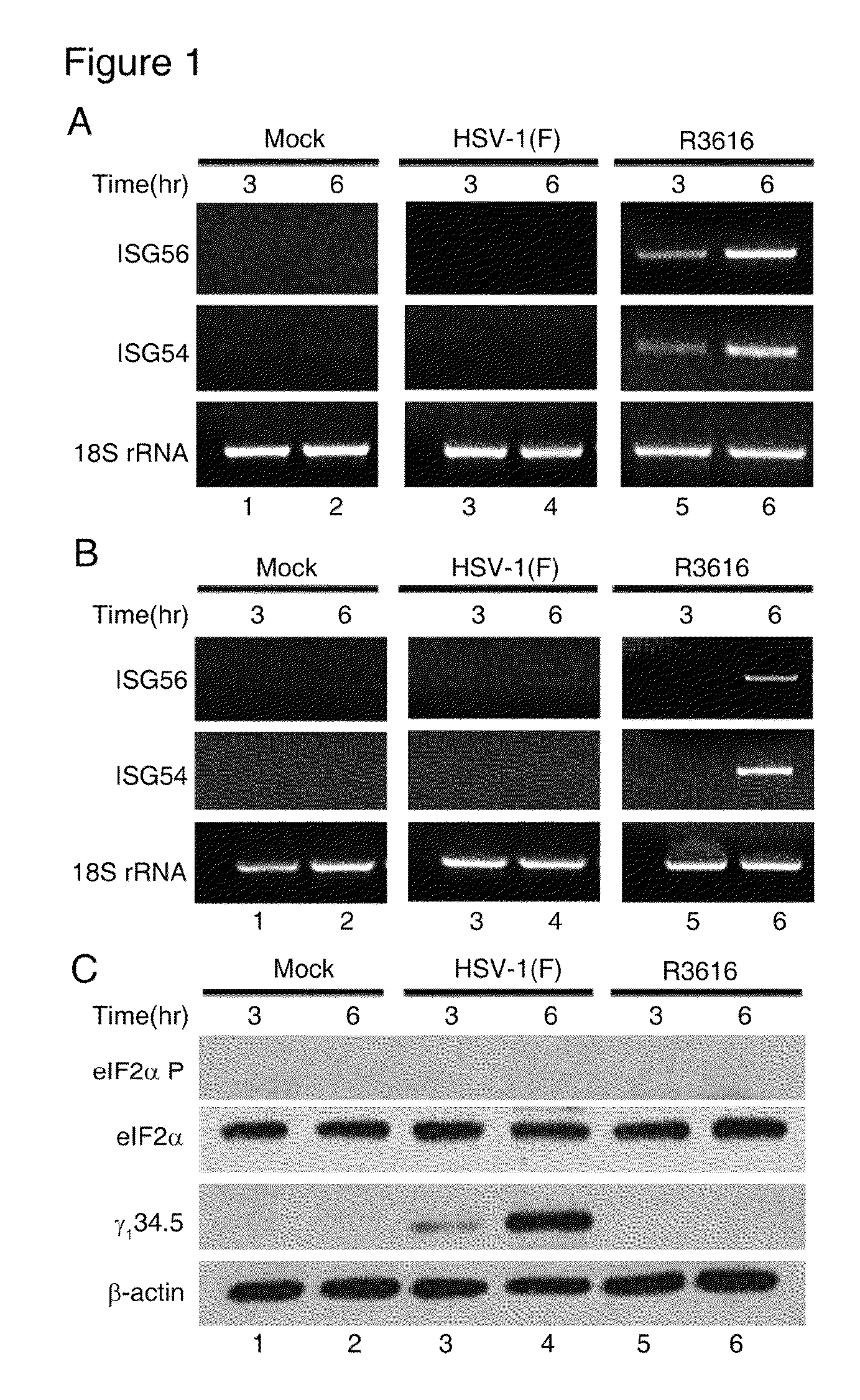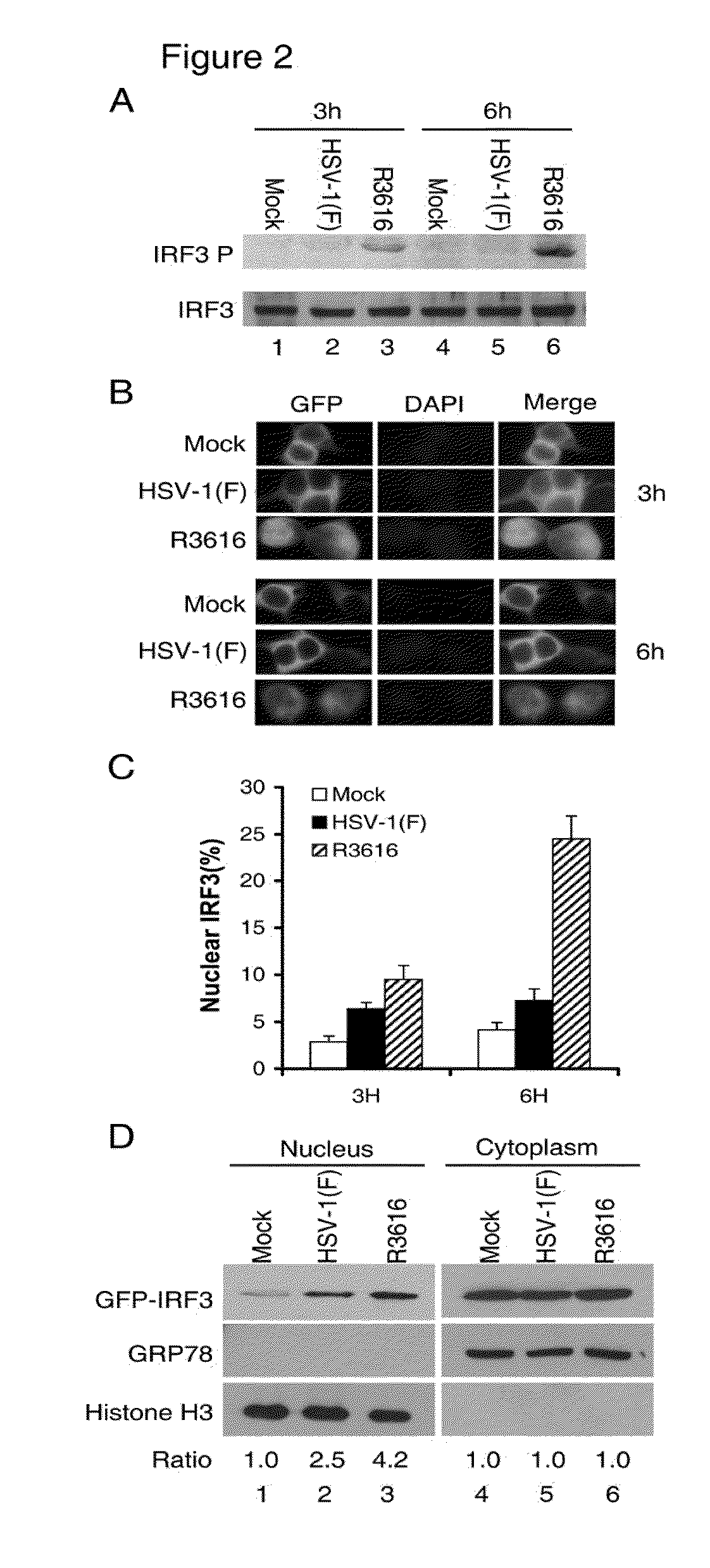Compositions and methods using herpes simplex virus
a technology of herpes simplex virus and composition method, which is applied in the field of composition method and herpes simplex virus, can solve the problems of significant morbidity and mortality, hsv infection is also a risk factor in hiv infection and transmission, and the expression of hsv proteins interferes with the induction of antiviral immunity, so as to prevent or reduce the incidence or severity of clinical signs, and the effect of provoking an immune respons
- Summary
- Abstract
- Description
- Claims
- Application Information
AI Technical Summary
Benefits of technology
Problems solved by technology
Method used
Image
Examples
example 1
Materials and Methods for Examples 2-6
[0099]Cells and Viruses—Vero, HEL, and 293T cells were from the American Type Culture Collection. TBK1+ / + and TBK1− / − MEF were gifts from Dr. Wen-Chen Yeh. Cells were propagated in Dulbecco's modified Eagle's medium supplemented with 5% (Vero and 293T) or 10% (MEF and HEL) fetal bovine serum. HSV-1(F) is a prototype HSV-1 strain used in this study. In recombinant virus R3616, a 1 kb fragment from the coding region of the γ134.5 gene was deleted. These viral strains were gifts from Dr. Bernard Roizman (University of Chicago).
[0100]Plasmids—Plasmids pcDNA3, pTK-Luc and dN200 have been described elsewhere. The FLAG-γ134.5 plasmids, WT, Δ30, Δ72, Δ106, Δ146, and N159, were constructed by inserting PCR amplified fragments into the BamHI and XhoI sites of pcDNA3. To construct GST-IRF3, a DNA fragment encoding amino acids 380 to 427 from IRF3 was ligated into the BamHI and EcoRI sites of pGEX4-T1. pISG56-Luc was a gift from Ganes Sen (The Cleveland Cli...
example 2
34.5 Null Mutant Activates Antiviral Immunity Early in HSV Infection
[0107]Although expressed as a leaky late gene, γ134.5 is also detectable early in infection. To explore the biological function of γ134.5, we measured the induction of ISG54 and ISG56 early in HSV infected cells. Mouse embryonic fibroblasts (MEF) were either mock infected or infected with viruses and mRNA levels were determined by RT-PCR. As illustrated in FIG. 1A, the induction of ISG54 as well as ISG56 was seen in cells infected with the γ134.5 null mutant R3616. The mRNA levels of ISG54 and ISG56 increased as virus infection progressed from 3 h to 6 h. This stimulation was not observed in cells mock infected or infected with wild type HSV-1(F) although comparable levels of 18sRNA were noted in all cells. In correlation, wild type virus, but not the γ134.5 null mutant, expressed the γ134.5 protein at 3 and 6 h after infection (FIG. 1C). Similar results were obtained in human lung fibroblasts (HEL) albeit there was...
example 3
34.5 Null Mutant Replicates More Efficiently in TBK1− / − Cells than in TBK1+ / + Cells
[0109]While HSV induction of antiviral responses involves different components, this process requires TBK1. We hypothesized whether there is a possible link between γ134.5 and the TBK1 pathway. To test this, we investigated viral growth properties in TBK1+ / + and TBK1− / − MEF cells. Specifically, cells were infected with either HSV-1(F) or R3616. At 24 h post infection, virus yields were determined. As shown in FIG. 3A, HSV-1(F) replicated efficiently in both TBK1+ / + and TBK1− / − cells, reaching titers of 4.6×106 and 1×106 pfu / ml, respectively. In striking contrast, R3616 replicated poorly in TBK1+ / + cells, with a virus yield less than 10 pfu / ml. There was approximately 105-fold decrease in viral growth as compared to HSV-1(F). This reduction was attributable to the lack of γ134.5 in R3616. Strikingly, R3616 replicated more efficiently in TBK1− / − cells, with a titer reaching 6.6×103 pfu / ml. There was app...
PUM
| Property | Measurement | Unit |
|---|---|---|
| molecular weights | aaaaa | aaaaa |
| molecular weights | aaaaa | aaaaa |
| molecular weights | aaaaa | aaaaa |
Abstract
Description
Claims
Application Information
 Login to View More
Login to View More - R&D
- Intellectual Property
- Life Sciences
- Materials
- Tech Scout
- Unparalleled Data Quality
- Higher Quality Content
- 60% Fewer Hallucinations
Browse by: Latest US Patents, China's latest patents, Technical Efficacy Thesaurus, Application Domain, Technology Topic, Popular Technical Reports.
© 2025 PatSnap. All rights reserved.Legal|Privacy policy|Modern Slavery Act Transparency Statement|Sitemap|About US| Contact US: help@patsnap.com



